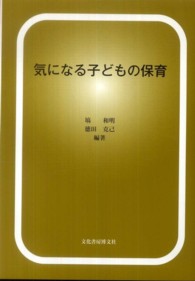- ホーム
- > 洋書
- > 英文書
- > Science / Mathematics
Full Description
Despite advances in robot technology, in which industrial manipulators have replaced mechanisms, cam mechanisms still find important industrial applications in the textile, food processing and manufacturing industries. This book is a modern, up-to-date treatise on the important subject of cam synthesis.
Cam mechanisms have been studied from different points of view, namely, kinematic synthesis, dynamic synthesis, analysis, design, optimization and manufacturing. This book is oriented to the kinematic synthesis of cam mechanisms in a unified framework, i.e. that spatial, spherical and planar cam mechanisms are integrated in the same formulation. Traditionally, the synthesis of the three types of cam mechanisms has been approached using independent formulations. With a unified formulation, both well known types of cam mechanisms, as well as novel cam mechanisms can be synthesized, as shown in the book. Moreover, since all the design parameters are considered in a unified framework, the optimization theory of cam mechanisms can be applied systematically, i.e. the criteria applied for the optimization of planar cam mechanisms, which can be found to some extent in the literature, can be complemented in order to provide general criteria for the optimization of spherical and spatial cam mechanisms.
The underlying philosophy of the book has been to exploit sound mathematical and kinematical tools of analysis and synthesis that could be used only with the available current software and hardware.
The approach and tools introduced in this book can assist the designer in producing a broad spectrum of mechanisms than those described in the book.
This will be an invaluable reference for engineering designers.
Contents
1 Preamble.- 1.1 Introductory Remarks.- 1.2 The Development of Cam Technology.- 1.3 Scope of the Book.- 1.4 Book Organization.- 2 Synthesis Tools.- 2.1 Dual Numbers.- 2.2 The Aronhold-Kennedy Theorem.- 2.3 Ruled-Surface Geometry.- 3 Kinematics of Three-Link Mechanisms.- 3.1 Introduction.- 3.2 Surface Geometry.- 3.3 Pressure Angle.- 4 Kinematics of Four-Link Mechanisms.- 4.1 Introduction.- 4.2 Roller-Followers.- 4.3 Pressure Angle.- 4.4 Three-Link Mechanisms with Constant Pressure Angle.- 5 Indexing Mechanisms.- 5.1 Introduction.- 5.2 Input-Output Function of Indexing Cam Mechanisms (ICM).- 5.3 ICM of RHR Type.- 5.4 ICM of RHCR Type.- 5.5 Pure Rolling with Indexing Cam Mechanisms.- 5.6 Positive Action and Positive Motion.- 6 The Volumetric Properties of Cams.- 6.1 Introduction.- 6.2 General Formulation.- 6.3 Planar Objects.- 6.4 Solids.- 6.5 An Outline of MOMENT.- 6.6 Volumetric Properties of Cams in Indexing Mechanisms.- 7 An Outline of Usycams.- 7.1 Introduction.- 7.2 On-Line vs. Off-Line Synthesis.- 7.3 General Description of USYCAMS.- 7.4 Main Menu.- 7.5 Submenus.- 7.6 Synthesis Procedures.- 7.7 Application Example.- 8 The Cad of Cam Mechanisms.- 8.1 Introduction.- 8.2 CAD-Based Methods. Planar Applications.- 8.3 Case Studies.- Appendices.- A Bibliography.- B Displacement Programs.- B.1 Generalized Input-Output Function.- B.2 Cycloidal Function.- B.3 Polynomial Functions.- B.3.1 3-4-5 Polynomial.- B.3.2 4-5-6-7 Polynomial.- B.4 Combined Functions.- B.4.1 Modified Trapezoidal Acceleration.- C Symbolic Dual Algebra.- C.1 CrossUnitDual.- C.2 DecompDual.- C.3 DivDual.- C.4 SqrtDual.- C.5 TanDual.- C.6 UnitDual.








